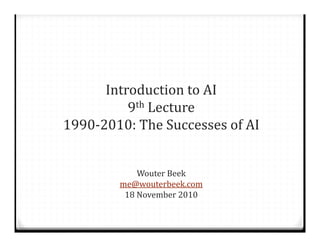
Introduction to AI - Ninth Lecture
- 3. Hybrid Architectures 0 Hybrid Architectures: combining the various agent architectures. 0 E.g. combining reflex components with knowledge‐ based components. 0 Compilation: convert declarative information at the deliberate level into more efficient representations, eventually reaching the reflex level. 0 Soar (1987), Theo (1990). 0 Solutions to new problems are derived by deliberation, but are compiled and stored at the reflex level for solving future occurrences of similar problems.
- 4. Real‐Time AI 0 Increasingly more complex environments: partially observable, multiagent, stochastic, sequential, dynamic and/or semidynamic, continuous, unknown. 0 Satisficing: deliberating long enough to come up with an answer that is good enough. 0 ‘Good’ is context‐dependent, i.e. with respect to a purpose. 0 Anytime Algorithms: there is always an output, which becomes better over time. 0 Bounded rationality: forms of rational behavior that adhere to the constraints of satisficing. 0 Bounded optimality: the best algorithm given the computational resource constraints.
- 5. Meta‐Cognition 0 Decision‐Theoretic Metareasoning: deciding which computations to perform (in what order) and which not. 0 Computations are characterized by costs and benefits: 0 Cost: time, memory, and knowledge input needed. 0 Benefit: the projected quality improvement of the system’s behavior due to the computation. 0 Computation ordering: an earlier computation’s benefit may be the knowledge input to later computations. 0 Reflective Architecture: combining environment state and computation state. An agents’ reasoning process becomes part of the environment (what is observed).
- 6. Multiagent Systems 0 Cooperation 0 Competition 0 Swarm intelligence: performance measure applied to collective behavior. 0 Decentralized representation 0 Emergent behavior 0 Weak emergence: the qualities of the system are reducible to the system's constituent parts. 0 Strong emergence: e.g. qualia. 0 The concepts of utility and rationality change! 0 What is rational for the swarm is not the sum of what is rational for all individuals.
- 7. Prisoner’s dilemma Prisoner B silent Prisoner B betray Prisoner A silent A:1 day, B: 1 day A:10 year, B:0 Prisoner A betray A:0, B:10 years A:9 years, B:9 years Two suspects are arrested. If one testifies against the other (betray) and the other remains silent, the betrayer goes free and the silent accomplice receives the full 10‐year sentence. If both remain silent, both prisoners are sentenced to only 1 day for not cooperating with the investigation. If each betrays the other, each receives a 9‐year sentence. How should the prisoners act? • No matter what the other player does, a player will always gain a greater payoff by playing betray. • Since in any situation betraying is more beneficial than remaining silent, all rational players will betray.
- 9. Autonomous Driver 0 DARPA Grand Challenge: competition for long distance, driverless vehicles. 0 Goal: making 1/3 of the military ground units autonomous. 0 2005, STANLEY: driverless robotic car wins the DARPA Grand Challenge, 212km off‐road course. 0 2006, BOSS: driverless robotic car in urban area.
- 10. Autonomous Planning 0 2000, RemoteAgent: on‐board autonomous planning, scheduling operations for spacecraft. NASA. 0 2004, MAPGEN: NASA’s Mars Exploration Rovers. 0 2008, MEXAR2, European Space Agency’s Mars Express.
- 11. Computational Linguistics 0 Speech recognition and dialogue handling in call centers 0 Automatic Translation 0 Hands‐free computing 0 Speech‐to‐text 0 Speaker identification 0 AI’s main interest in the 1960’s.
- 12. Games Chess 0 1997, Deep Blue (IBM): the first computer to beat the world champion in chess, 3.5‐2.5. 0 “The brain’s last stand.” [Newsweek] 0 IBM’s stock increased by $18.000.000.000. 0 2004, Hydra defeats world champion Ponomariov 2‐0. 0 Elo rating 2850‐3000, higher than that of any human. 0 2007, Rybka defeats several grand masters, even when giving them certain advantages. Checkers: 1994, Chinook becomes the world champion. Go: MoGo, still performs at advanced amateur level. 0 There is still work to do on some games.
- 14. Automatic Classification 0 Pattern recognition 0 Discovering complicated interactions: e.g. drug use, medical imaging. 0 OCR 0 Handwriting recognition 0 Biometric identification 0 Credit card usage 0 Document classification 0 Classifying 1.000.000.000 spam messages every day. 0 Search
- 15. Logistics planning 0 1991, DART (Dynamic Analysis and Replanning Tool) scheduled transportation during the Persian Gulf crisis. 0 Starting points, destinations, routes, conflict resolution. 0 Over 50.000 vehicles, cargo, people. 0 According to DARPA, this system alone paid back 30 years of investment in AI.
- 17. Robotics Toys: 0 ASIMO 0 1997‐present, RoboCup 0 TOPIO, table tennis Practical applications: 0 Industrial Robotics 0 2.000.000 Roombas sold by iRobot corporation! 0 Robotic vacuum cleaners…
- 18. Neurological Simulation 0 Blue Brain Project: A neurologically realistic model of neurons. 0 Blue Gene supercomputer 0 NEURON software 0 2007, simulating a rat’s neocortical column (functional part of the neocortex). 0 2009, director Henry Markram announced to build a human brain in 10 years time. 0 Think of what you learned about the history of AI. What is wrong with Markram’s announcement?
